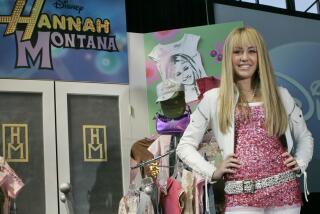Pay TV Fights to Win Back Restive Viewers : Media: Cost-conscious subscribers are bailing out. The industry is sharply divided on how to reverse the trend.
- Share via
June Kennedy is one reason why HBO and Showtime executives are biting their nails.
The 36-year-old Los Angeles social worker recently dropped the two pay TV channels after trying them out for more than a year because “they just show the same movies over and over again.”
“I know that I can go to the video store and rent a movie for $1.90,” Kennedy said. “It just seems to me that paying $20 extra a month for cable is no longer worth it.”
Cost-conscious viewers such as Kennedy are increasingly turning off pay channels such as HBO, Showtime, Cinemax and the Movie Channel. Total subscriptions for the top four pay channels last year shrunk about 2% nationally--the first reversal in the 15-year history of pay television.
The trend is alarming for the industry because pay TV channels were behind cable television’s surging growth in the 1980s. Viewers liked the novelty of watching uncut, commercial-free movies years before they appeared on the networks.
“Pay TV drove the industry,” explains John Sie, chairman of Encore, a new, low-cost pay channel designed to lure subscribers back to pay television. “It defined cable television.”
But no longer. The proliferation of home video and VCRs, improvements in programming on basic cable TV channels such as USA Network and TNT, a sharp rise in the cost of basic service and a failure of HBO and Showtime to reposition themselves in a more segmented market have all contributed to a loss in pay TV subscribers over the last two years.
The problem is aggravated because the cable TV industry is sharply divided about how to win back subscribers.
Cable networks believe that the solution is to offer two or three different channels at no extra cost--known as “multiplexing” in the industry. Others contend that the answer lies in new discount pay channels.
How much cable subscribers are willing to shell out for pay TV, and their perception of what they get for it is at the heart of the debate within the industry on how to reverse pay TV’s precipitous slide.
Today, only 40% of cable subscribers are willing to spend an extra $10 a month or more for a pay TV channel. A few years ago, the figure stood at 47%.
A major impediment in subscribing to extra pay channels is the escalation in the cost of basic cable, which now approaches $25 a month in some places.
“When the rates go up like that, some people are going to do away with the discretionary product,” said Ajit Dalvi, senior vice president of Cox Cable Communications in Atlanta.
Since most cable TV executives agree that the ceiling has been hit in terms of what consumers are willing to pay, efforts are now focused on giving subscribers more choices for the same money.
The best example of that strategy is multiplexing. Four of the five major pay TV channels are either rolling out or have announced multiplexing plans.
In theory, at least, multiplexing is straightforward.
A pay TV channel such as HBO transmits the same programming at different times on three separate channels for the price of one--what cable TV executives label “time shifting.” So while a movie may be on HBO-1, a comedy is playing on HBO-2 and a drama on HBO-3. The assumption is that subscribers like the programming but have been turned off because the movies and other programs are not scheduled at convenient times.
“Our goal is to keep people from disconnecting,” says Elizabeth Bruce, vice president of HBO.
So far, HBO says it is encouraged by the results from multiplexing. A recent survey among the approximately 800,000 households that get two or more channels of HBO found that viewing of the pay channel was up 47%.
But the problem is that many cable TV operators are afraid that multiplexing HBO will actually discourage subscribers from buying additional pay TV channels.
In fact, this already appears to be happening in some cable systems. The Disney Channel, for example--the only pay TV network to show growth last year--said it lost 4% of subscribers in some cable TV systems where HBO multiplexing was recently introduced.
This is potentially troublesome for Disney because 75% of its subscribers buy the channel in combination with another pay TV service.
Not surprisingly, Disney has concluded that its best defense is a good offense. So it too will begin multiplexing this fall.
“Multiplexing as a major force is going to take a while in coming because there is no channel capacitysays John Cooke, president of the Disney Channel..
The typical cable system has only about 35 channels, making it difficult for new networks to get on without elbowing out another service. Nonetheless, many basic cable networks are also planning to multiplex.
Still, some cable TV executives question whether multiplexing really masks a more fundamental problem with pay television.
“If subscribers are genuinely dissatisfied with the programming, then giving them more of the thing they don’t like only exacerbates the problem,” argues Encore’s Sie.
His solution is to offer subscribers a low-cost pay TV channel either by itself or as part of a package with other pay channels. He launched Encore last year with the help of Denver-based cable giant Tele-Communications Inc.
Liberty Media Corp., a spinoff from TCI, spent more than $30 million last year to launch Encore and buy about 1,000 older movies. The channel is now seen in about 3.5 million homes, still modest compared to HBO’s 17.3 million, but surpassing the Movie Channel’s 2.6 million.
“Most people who left pay TV are in the 30-plus-year-old category “ explains Sie. “Encore targets those viewers.”
Unlike HBO and Showtime, which show major film releases about a year after they appear in theaters--most of Encore’s films were seen on free television years ago--such as “Doctor Zhivago” and “Planet of The Apes.” Sie says they are the kind of films baby boomers hunt down in the video stores.
In the marketing-intensive cable TV business, executives freely admit that they are trying to copy the successful strategies of the giant soft drink companies that slug it out for valuable shelf space.
Cox’s Dalvi notes the Coca-Cola Co. has long managed to keep its market share by repositioning the product every few years by creating “line extensions” such as Coke Classic and Diet Coke. It also has fought off new competing brands.
Dalvi says that multiplexing pay TV is like a line extension of a soft drink, while new, low-cost pay channels are equivalent to the introduction of new brands.
The difference, he says, is that Coke and Pepsi have invested billions of dollars over the years to build a consumer identity, while the younger cable TV--is embroiled in an industrywide marketing squabble.
Ultimately, Dalvi says, multiplexing and low-cost pay TV channels are not mutually exclusive. He believes that some cable operators will inevitably have to charge less if they want to woo back their pay TV customers.
“It’s Marketing 101,” he says.
The Slide in Pay TV Pay channels like HBO and Showtime, which once defined the lure of cable TV, have lost ground over the past two years. Last year, pay TV channels, with the exception of the Disney Channel, actually lost subscribers for the first time in the 15-year history of the business. (No. of Subscribers in millions)
Service 1985 1986 1987 1988 1989 1990 1991 HBO 14.6 15.0 15.9 17.0 17.3 17.6 17.3* Showtime* 5.3 5.3 5.9 6.7 7.3 7.4 7.3 Cinemax 3.7 4.2 5.1 6.0 6.4 6.3 6.3 Disney Channel 2.5 3.1 3.8 4.3 5.0 5.6 6.2 Movie Channel 3.1 2.8 2.5 2.7 2.8 2.8 2.6
Source: Company reports, Paul Kagan Associates
More to Read
The biggest entertainment stories
Get our big stories about Hollywood, film, television, music, arts, culture and more right in your inbox as soon as they publish.
You may occasionally receive promotional content from the Los Angeles Times.










